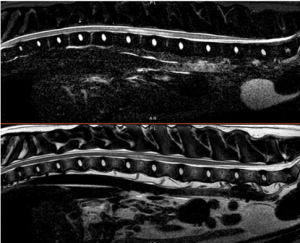Ischaemic Myelopathy
Back to Fact Sheets
Ischaemic myelopathy is caused by a sudden obstruction of the blood vessels which supply the spinal cord.
Download PDF
What is ischaemic myelopathy?
Ischaemic myelopathy is caused by a sudden obstruction of the blood vessels which supply the spinal cord. The obstruction is often caused by fibro-cartilage originating from the intervertebral discs, which act like ‘shock absorbers’ and sit between the bones of the vertebral column. For this reason, the condition is sometimes referred to as ‘fibrocartilaginous embolism’ (often abbreviated to ‘FCE’). Other causes of blood vessel obstruction could include a blood clot or abnormal cells originating from elsewhere in the body (e.g. an abscess or tumour). Ischaemic myelopathy can be likened to a ‘stroke’ in people, except the affected region is the spinal cord rather than the brain. The obstruction to the blood supply causes damage to the spinal cord which is subsequently deprived of oxygen and nutrients.
What are the clinical signs of ischaemic myelopathy?
Clinical signs are often very sudden in onset and do not tend to progress beyond 24 hours. Your dog might experience weakness on his/her limbs or difficulties walking. Often the onset of ischaemic myelopathy can be associated with strenuous exercise or a mild trauma (e.g. slipping over while catching a ball, running, playing). Although pets can be very stressed and cry out at initial onset of signs, the condition is not typically associated with pain. Clinical signs are often very lateralised/ asymmetrical with one side of the body being more severely affected than the other side. Large and giant breeds are more commonly affected, however small dogs and occasionally cats can also suffer ischaemic myelopathy.
How is ischaemic myelopathy diagnosed?
Magnetic resonance imaging (MRI) is the gold-standard method to diagnose ischaemic myelopathy as it provides excellent detail on the soft tissue of the spinal cord. At Southfields we can provide emergency MRI and rapid diagnosis. The MRI findings associated with this condition are well characterised on MRI. In one study of dogs with suspected ischaemic myelopathy, 21% of dogs did not have any apparent spinal cord changes; the absence of changes on MRI was associated with dogs which had more mild clinical signs. MRI also allows exclusion of other possible causes of clinical signs such as intervertebral disc disease that will require prompt treatment.

RI of a dog with an ischaemic myelopathy (arrowed)
How can ischaemic myelopathy be treated?
There is no specific or targeted treatment for ischaemic myelopathy. Rehabilitation with supportive nursing care and physiotherapy are the cornerstones of the management. Soft well padded bedding, bladder management, adequate nutrition, and regular turning to prevent pressure sores developing are essential. Land based physiotherapy and hydrotherapy with a suitably qualified organisation is also recommended. At Southfields we will make sure your dog has a physiotherapy plan ready to go home with as well as an exercise routine and nutrition plan.
What is the outcome for patients with ischaemic myelopathy?
Ischemic myelopathy has overall a good prognosis and the majority of pets recover a normal neurological function in the weeks following injury. Long-term complications may include residual weakness on the affected limb or incontinence but these are reserved to severe cases. The severity of clinical signs at initial presentation might determine patient outcome; patients which do not have any movement or sensation in affected limbs might have a poor prognosis for recovery. Additionally, more extensive spinal cord changes on MRI, and involvement of the spinal cord which is directly overlying the limbs, might help determining the prognosis.


